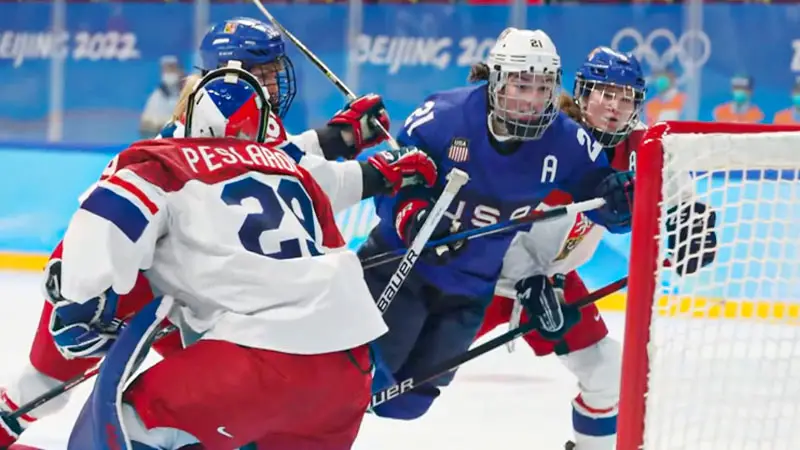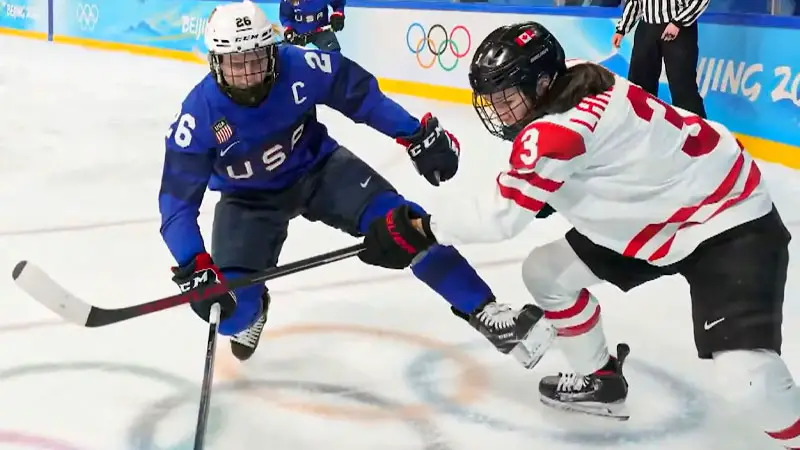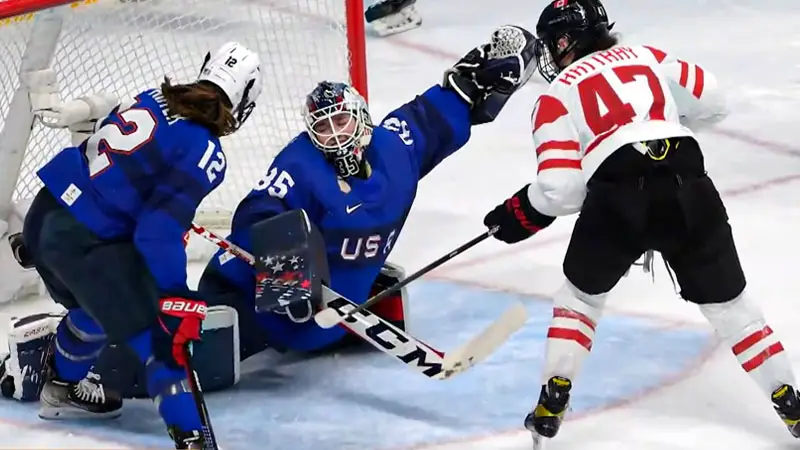In the dynamic world of hockey, the rules governing body-checking stand as a pivotal factor that shapes the sport’s identity.
While body-checking is a prominent feature in men’s hockey, its absence in women’s hockey sparks curiosity and debate.
This blog post delves into the nuanced reasons behind why is body-checking illegal in women’s hockey, exploring the multifaceted considerations that have influenced this decision.
From player safety concerns to the evolution of the women’s game, we unravel the complexities surrounding this rule, shedding light on how it impacts gameplay and the broader landscape of women’s hockey. So, stay sharp.
Body-Checking in Women’s Hockey
Body-checking is a fundamental aspect of ice hockey, known for its physicality and strategic deployment.
While men’s hockey has a long-established tradition of body-checking, women’s hockey has undergone changes in recent years regarding the inclusion of this element.
In this context, it is crucial to explore the dynamics of body-checking in women’s hockey and its impact on the game.
Historical Perspectives
In the early years of women’s hockey, body-checking was often discouraged due to concerns about player safety and the perception of the sport as more finesse-oriented.
However, over time, attitudes have evolved, and the acceptance of body-checking in women’s hockey has increased, aligning more closely with the physical nature of the men’s game.
Strategic Considerations
The introduction of body-checking in women’s hockey has brought about a shift in team strategies.
Coaches now need to integrate this physical element into their game plans, emphasizing the importance of both offensive and defensive body-checking to gain a competitive edge.
This shift has led to a more dynamic and diverse style of play in women’s hockey.
Player Development and Safety
As body-checking becomes a more integral part of women’s hockey, player development programs have adapted to ensure that athletes are equipped with the necessary skills and techniques to execute and withstand body-checks safely.
Striking a balance between physicality and player safety is paramount, necessitating comprehensive training programs and rule adaptations.
Impact on Spectator Engagement
The inclusion of body-checking in women’s hockey has not only changed the dynamics on the ice but has also contributed to increased spectator engagement.
Fans are drawn to the intensity and physicality of the game, resulting in a broader appeal for women’s hockey and a positive impact on the sport’s visibility and popularity.
Continued Debate and Evolution
Despite the positive changes, the debate around body-checking in women’s hockey continues.
Some argue that it enhances the sport’s competitiveness and entertainment value, while others express concerns about player safety and the potential for injuries.
The ongoing discourse emphasizes the need for continuous evaluation and potential rule adjustments to strike an optimal balance in the evolving landscape of women’s hockey.
Why Is Body-Checking Illegal in Women’s Hockey?

Body-checking is illegal in women’s hockey primarily due to concerns surrounding player safety and the desire to maintain a distinct style of play.
The decision to prohibit body-checking stems from the recognition that women’s hockey traditionally emphasizes skill, finesse, and teamwork over the physicality inherent in men’s hockey.
The governing bodies and stakeholders in women’s hockey aim to create an environment where players can compete at a high level without undue risk of injury.
By prohibiting body-checking, they intend to mitigate the potential for collisions that may lead to injuries, especially considering the physiological differences between male and female athletes.
This approach aligns with the broader goal of fostering a game that emphasizes skill development, and fair competition, allowing women’s hockey to carve its unique identity while prioritizing the well-being of the athletes on the ice.
Arguments Against the Ban on Body-Checking in Women’s Hockey
While the ban on body-checking in women’s hockey is aimed at prioritizing player safety and preserving a distinct style of play, there are arguments against this prohibition.
Advocates for allowing body-checking in women’s hockey put forth compelling points that challenge the current restrictions.
Equal Opportunities for Skill Development
Critics argue that allowing body-checking provides female players with equal opportunities to develop a diverse set of skills.
Embracing physicality in the game can enhance players’ abilities to navigate challenging situations, contributing to a more comprehensive skill set that mirrors the dynamics of men’s hockey.
Increased Spectator Engagement
Some argue that permitting body-checking in women’s hockey could boost spectator engagement.
The physical aspect of the game is often seen as thrilling by fans, and introducing body-checking may attract a broader audience, generating more interest and support for women’s hockey.
Preparation for International Competitions
Supporters of body-checking contend that allowing it at the domestic level better prepares female players for international competitions.
Since body-checking is permitted in many international women’s tournaments, incorporating it into domestic play could better equip athletes for the heightened physicality they may encounter at the global level.
Empowerment and Choice for Players
Some players argue for the right to choose a more physical style of play.
Allowing body-checking provides athletes the freedom to adopt a style that suits their strengths and preferences, empowering them to express their individuality on the ice.
This argument aligns with the broader movement towards inclusivity and diversity in sports.
Evolution of the Women’s Game
Proponents of body-checking assert that women’s hockey should evolve in tandem with changing perceptions and preferences.
As attitudes towards gender roles in sports evolve, there is a growing belief that women’s hockey can embrace physicality without compromising the essence of the game, fostering a more dynamic and exciting brand of play.
Comparisons Between Body-Checking in Men and Women’s Hockey

The presence and nature of body-checking in hockey differ between men’s and women’s games, reflecting the unique dynamics and expectations within each context.
Understanding these distinctions is crucial for appreciating the nuanced aspects of both versions of the sport.
Frequency and Intensity
One notable difference lies in the frequency and intensity of body-checking. Men’s hockey is traditionally characterized by more frequent and forceful body checks, often integral to the strategic aspects of the game.
In contrast, women’s hockey tends to exhibit fewer instances of body-checking, with a greater emphasis on skill and finesse.
Acceptance and Cultural Norms
The acceptance of body-checking varies between the two genders. Men’s hockey has a long-standing tradition of physical play, and body-checking is widely accepted as a fundamental aspect of the game.
In women’s hockey, the cultural norms around body-checking have evolved over time, with debates and rule changes shaping its place in the sport.
Impact on Gameplay Style
The presence or absence of body-checking significantly influences the overall style of play in both men’s and women’s hockey.
Men’s hockey often relies on the physicality of body checks to disrupt opponents and create scoring opportunities.
In women’s hockey, the emphasis is placed more on puck handling, strategic positioning, and teamwork due to the restrictions on body-checking.
Player Safety Considerations
Player safety is a crucial aspect that influences the approach to body-checking in both men’s and women’s hockey. Due to physiological differences, the potential for injury may vary between male and female players.
Rule modifications and safety protocols are implemented in both versions of the sport, but they may differ to accommodate these physiological distinctions.
Evolution and Adaptation
Both men’s and women’s hockey have witnessed shifts in attitudes towards body-checking.
Women’s hockey has seen a gradual acceptance and incorporation of body-checking, albeit to a lesser extent than in the men’s game.
As the sport evolves, ongoing discussions and adaptations in rules continue to shape the role of body-checking in both men’s and women’s hockey, reflecting broader changes in the world of sports.
Gender Equality in Hockey
Gender equality in hockey is a vital aspect that extends beyond player participation to encompass various facets of the sport.
Addressing disparities and promoting equal opportunities is crucial for fostering inclusivity and ensuring that both male and female players, coaches, and stakeholders have equitable experiences in the hockey community.
Equal Access to Resources
Achieving gender equality in hockey starts with ensuring that both male and female players have equal access to resources, including facilities, equipment, and training opportunities.
Investing in infrastructure and development programs that cater to both genders helps create a level playing field and encourages talent from all backgrounds.
Parity in Competition and Recognition
Gender equality in hockey is reflected in providing equal opportunities for competition and recognition. This involves supporting women’s leagues, tournaments, and events at a level comparable to their male counterparts.
Establishing a balance in coverage, sponsorship, and promotional efforts helps raise the profile of women’s hockey and fosters a sense of equality within the broader hockey community.
Representation in Leadership and Coaching Roles
Ensuring gender equality extends to leadership and coaching roles within hockey organizations.
Promoting diversity and inclusivity in decision-making positions not only empowers women in the sport but also provides positive role models for aspiring female players.
Encouraging more women to take on coaching roles and leadership positions contributes to a more balanced and inclusive hockey landscape.
Elimination of Stereotypes and Biases
Achieving gender equality in hockey requires challenging and eliminating stereotypes and biases that may exist within the sport.
This involves changing perceptions about the roles of male and female players, acknowledging the diverse skill sets each gender brings to the game, and dispelling outdated notions that may hinder the progress of women in hockey.
Investment in Grassroots Development
Building a foundation for gender equality in hockey starts at the grassroots level. Investing in youth development programs that are accessible to both boys and girls ensures that talent is identified and nurtured early on.
Creating inclusive and supportive environments at the youth level contributes to a more equitable future for hockey, fostering a generation of players who view the sport as truly accessible to all, regardless of gender.
FAQs
Why is body-checking not allowed in women’s hockey?
Body-checking is restricted in women’s hockey to prioritize player safety and maintain a style of play that emphasizes skill and finesse.
The governing bodies aim to reduce the risk of injuries and create an environment that aligns with the unique dynamics of women’s hockey.
How does the ban on body-checking impact the game?
The ban on body-checking in women’s hockey influences the style of play, fostering a game that relies more on puck handling, strategic positioning, and teamwork.
It aims to create a distinct identity for women’s hockey while prioritizing a safer and skill-oriented approach.
Are there concerns about gender-based differences in body-checking?
Yes, concerns exist regarding gender-based differences in body-checking due to physiological variations.
Rules are adapted to ensure player safety, recognizing the distinct physical characteristics of female athletes and striving for an inclusive approach that promotes fair competition without compromising safety.
Could body-checking benefit women’s hockey?
Some argue that allowing body-checking could enhance women’s hockey by providing players with additional skills and increasing spectator engagement.
However, concerns about player safety and the potential for injuries have led to ongoing debates and a cautious approach to the inclusion of body-checking.
How does the ban contribute to the development of women’s hockey?
The ban on body-checking contributes to the development of women’s hockey by promoting a focus on skill development, strategic gameplay, and fair competition.
It creates an environment where athletes can thrive and showcase their abilities while maintaining a commitment to player safety and the growth of the sport.
Wrapping Up
In the pursuit of creating an inclusive and captivating environment for athletes, the ban on body-checking in women’s hockey signifies a deliberate effort to prioritize skill, finesse, and safety.
As the sport evolves, ongoing discussions about the role of physicality in women’s hockey continue, reflecting a delicate balance between tradition and progress.
Understanding the reasons behind this prohibition illuminates the unique characteristics that define women’s hockey, highlighting its distinct journey within the broader realm of the sport. Thank you so much.








James Felix